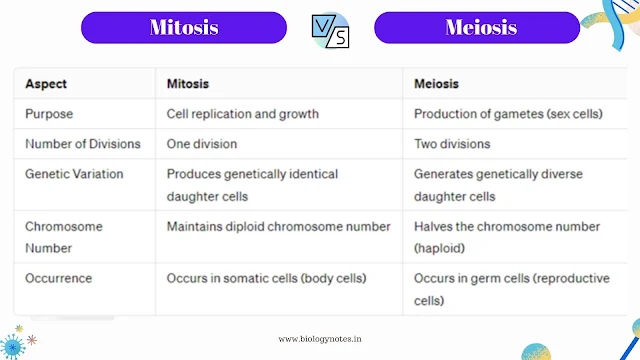Distinguish between Mitosis and Meiosis for Class 9, 10 and 11 :
Have you ever thought about two special words: “Mitosis” and “Meiosis”? They may seem similar, but they are actually very different! Today, we will explore them together and learn how to use them properly. So, let's check the major difference between Mitosis and Meiosis in simple words!
Here below a PDF document provides a detailed explanation of the differences between mitosis and meiosis, often including diagrams and examples to illustrate the distinctions.
Mitosis is a type of cell division that results in two identical daughter cells with the same number of chromosomes as the parent cell.
Meiosis is a special type of cell division that produces four genetically different daughter cells with half the number of chromosomes as the parent cell.
Similarities between mitosis and meiosis:
- Both mitosis and meiosis are processes of cell division.
- Both processes are preceded by a phase of cell growth and DNA replication called interphase.
- Both processes involve the segregation of chromosomes into daughter cells.
- Both mitosis and meiosis have similar stages including prophase, metaphase, anaphase, and telophase.
- Both processes are followed by cytokinesis, where the cytoplasm divides, forming two separate daughter cells.
- Both mitosis and meiosis occur in eukaryotic cells.
- Both mitosis and meiosis are essential for growth, development, and reproduction in multicellular organisms.
What is the difference between mitosis and meiosis:
Mitosis is a type of cell division that results in two identical daughter cells with the same number of chromosomes as the parent cell.
Meiosis is a special type of cell division that produces four genetically different daughter cells with half the number of chromosomes as the parent cell.
Mitosis is involved in growth, tissue repair, and asexual reproduction, while meiosis is involved in sexual reproduction to ensure genetic diversity.
| Mitosis | Meiosis |
|---|---|
| Mitosis discovered by Walther Flemming | Meiosis was discovered by Oscar hertwig |
| Mitosis occurs in all organisms, except for viruses |
Meiosis occurs only in animals, plant and fungi |
| Mitosis creates body / somatic cells | Meiosis crests germ/sex cells |
| Mitosis involves one-cell division | Meiosis involves two successive cell division |
| Mitosis performs general growth repairs, Cell reproduction. |
Meiosis performs genetic diversity through sexual reproduction |
Mitosis is the process where the division of cells occur by asexual reproduction |
Meiosis is the process Where the division of cells occur by sexual reproduction |
| In mitosis number of chromosomes remain the same |
In meiosis, the number of chromosomes is reduced by half |
| In mitosis, Tetrad formation does not occur. | In meiosis, tetrad formation Occurs and it's Consists of two sets of sister chromatids |
| In mitosis sister chromatids separate | In meiosis, sister chromatids do not separate |
In mitosis length of prophase is short. |
In meiosis length of prophase I is long and it's consist of five stages leptotene, zygotene, pachytene, Diplotene and diakinesis. |
Difference between mitosis and meiosis Table
List the main differences between mitosis and meiosis
FAQs Difference between Mitosis and Meiosis Table
1. What are the 5 differences between mitosis and meiosis?
Answer: Mitosis is a type of cell division that produces two identical daughter cells with the same number of chromosomes as the parent cell, while meiosis is a special type of cell division that produces gametes (sperm and egg cells) with half the number of chromosomes as the parent cell.
The five main differences between mitosis and meiosis are:
- Mitosis produces two identical daughter cells, whereas meiosis produces four genetically different daughter cells.
- Mitosis occurs in somatic cells, while meiosis occurs in germ cells to produce gametes.
- Mitosis involves one round of cell division, while meiosis involves two rounds of cell division.
- Mitosis results in diploid daughter cells (having the same number of chromosomes as the parent cell), while meiosis results in haploid daughter cells (having half the number of chromosomes as the parent cell).
- Mitosis is involved in growth, tissue repair, and asexual reproduction, while meiosis is involved in sexual reproduction to ensure genetic diversity.
2. What is the difference between mitosis and meiosis Class 10 Ncert?
Answer: In Class 10 NCERT, the main difference between mitosis and meiosis is highlighted as mitosis is a type of cell division that produces two identical daughter cells with the same number of chromosomes, while meiosis is a process of cell division that produces four genetically different daughter cells with half the number of chromosomes.
3. What are two major differences between mitosis and meiosis?
Answer: Two major differences between mitosis and meiosis are:
a. Mitosis produces two daughter cells, while meiosis produces four daughter cells.
b. Mitosis results in genetically identical daughter cells, while meiosis results in genetically diverse daughter cells.
4. What are the similarities between mitosis and meiosis?
Answer: Some similarities between mitosis and meiosis include:
a. Both processes involve the division of a parent cell's nucleus.
b. Both processes involve the separation of chromosomes into daughter cells.
c. Both processes occur in eukaryotic cells.
5. How do you remember the difference between mitosis and meiosis?
Answer: To remember the difference between mitosis and meiosis, one can use memory aids like mnemonic devices, such as "MITOSIS: Makes Identical Twins; MEIOSIS: Makes Eggs (and) Sperm."
